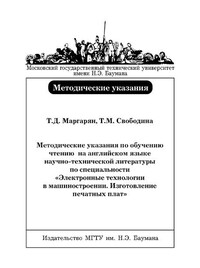Методические указания по обучению чтению на английском языке научно-технической литературы по специальности «Электронные технологии в машиностроении. Изготовление печатных плат»
Покупка
Тематика:
Английский язык
Год издания: 2006
Кол-во страниц: 28
Дополнительно
Вид издания:
Учебно-методическая литература
Уровень образования:
ВО - Бакалавриат
ISBN: 5-7038-2845-7
Артикул: 840463.01.99
Пособие состоит из ряда текстов для чтения, перевода и аннотирования. Каждый текст является описанием одного из этапов процесса изготовления печатных плат. Тексты сопровождаются терминологическими словарями и заданиями. Задания направлены на закрепление и активизацию грамматического материала, усвоение специальной лексики и умение работать с оригинальным текстом на английском языке. Для студентов IV курса, обучающихся на факультете МТ по специальности «Электронные технологии в машиностроении».
Тематика:
ББК:
УДК:
- 621: Общее машиностроение. Ядерная техника. Электротехника. Технология машиностроения в целом
- 80: Общие вопросы филологии, лингвистики и литературы. Риторика
- 811111: Английский язык
ОКСО:
- ВО - Бакалавриат
- 15.03.01: Машиностроение
- ВО - Магистратура
- 11.04.04: Электроника и наноэлектроника
ГРНТИ:
Скопировать запись
Фрагмент текстового слоя документа размещен для индексирующих роботов
МОСКОВСКИЙ ГОСУДАРСТВЕННЫЙ ТЕХНИЧЕСКИЙ УНИВЕРСИТЕТ им. Н.Э. БАУМАНА Т.Д. Маргарян, Т.М. Свободина Методические указания по обучению чтению на английском языке научно-технической литературы по специальности «Электронные технологии в машиностроении. Изготовление печатных плат» М о с к в а Издательство МГТУ им. Н.Э. Баумана 2 0 0 6
УДК 802.0
ББК 81.2Англ-923
М25
Рецензент Т.И. Кузнецова
Маргарян Т.Д. Свободина Т.М.
Методические указания по обучению чтению на английском языке научно-технической литературы по специальности «Электронные технологии в машиностроении. Изготовление печатных плат». – М.: Изд-во МГТУ им. Н.Э. Баумана,
2006. – 28 с.: ил.
ISBN 5-7038-2845-7
Пособие состоит из ряда текстов для чтения, перевода и аннотирования. Каждый текст является описанием одного из этапов процесса изготовления печатных плат. Тексты сопровождаются терминологическими словарями и заданиями. Задания направлены на закрепление и активизацию
грамматического материала, усвоение специальной лексики и умение работать с оригинальным текстом на английском языке.
Для студентов IV курса, обучающихся на факультете МТ по специальности «Электронные технологии в машиностроении».
УДК 802.0
ББК 81.2Англ-923
Методическое издание
Татьяна Дмитриевна Маргарян
Татьяна Михайловна Свободина
Методические указания по обучению чтению на английском языке
научно-технической литературы по специальности «Электронные
технологии в машиностроении. Изготовление печатных плат»
Корректор М.А. Василевская
Компьютерная верстка О.В. Беляевой
Подписано в печать 06.02.2006. Формат 60×84/16. Бумага офсетная.
Печ. л. 1,75. Усл. печ. л. 1,63. Уч.-изд. л. 1,55. Тираж 300 экз.
Изд. № 138. Заказ
Издательство МГТУ им. Н.Э. Баумана.
105005, Москва, 2-я Бауманская, 5.
ISBN 5-7038-2845-7 © МГТУ им. Н.Э. Баумана, 2006
М25
§ 1. Introduction Preliminary exercises I. Learn the words below. acquaint – знакомить, информировать ambiguity [æmbı'gju(:)ıtı] – двусмысленность, неясность depart from – сворачивать в сторону, отступать manual – пособие, справочник glossary – глоссарий, толковый словарь к тексту industry-wide standards – крупносерийные образцы outline – план, схема silk screen – трафарет soldermask – слепок припоя, паяльная маска take into account – принимать во внимание screening – экспонирование II. Read and translate the text. The purpose of the manual is to acquaint the reader with the manu facture of printed circuit boards in general. It is written for someone having a basic understanding of how PC boards are made but lacking the detailed knowledge. It contains a glossary of terms, which occasionally raise questions or lead to ambiguities. You can find detailed information on different aspects of PC board fabrication. Let us start with the description of how a double-sided printed cir cuit board with plated through holes is manufactured. Multilayers will be discussed later. To correctly produce the circuits a sufficiently complete set of documents is required. This means that the manufacturer must know the number of layers, what printed circuit board material and lamination thickness are to be used, where to drill all the holes, what the various hole sizes are, which holes are plated through and which are not. We must obtain or be able to produce a photographic image of the printed circuitry to be produced on each layer of the board as well as photos for the soldermask and silk screen, if required. The documentation must define the shape and size of the finished circuits. Other features of the boards, which depart from industry-wide standards, must be defined if they are to be taken into account during fabrication. Rather than by beginning with a complete description of the many ways in which this information can be provided, it will be better to go through a discussion of the various processing steps.


